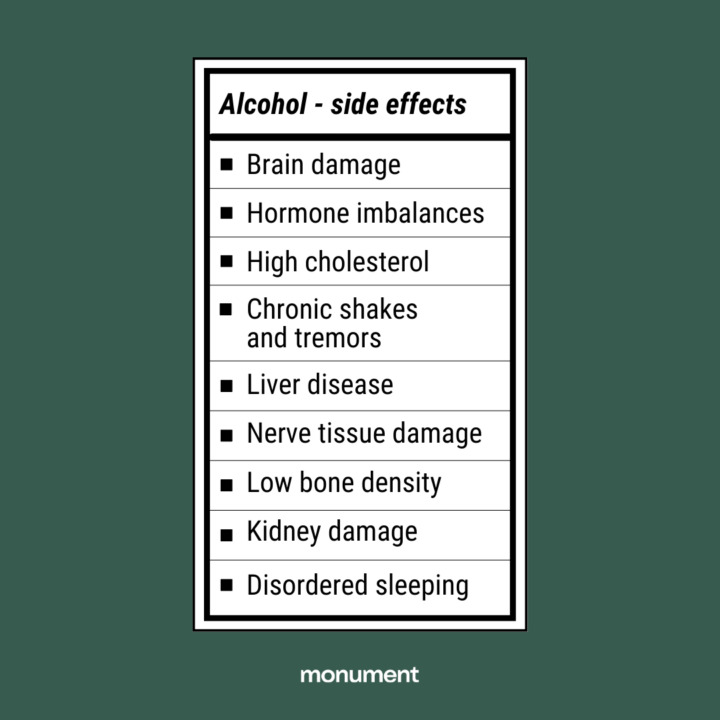Humans have an incredible capacity for complex and deep thinking. Additionally, we deeply value core memories that form us into the individuals we are now. As we age, it can be distressing to notice our memories seem to cloud, and that it’s more difficult to maintain a sequence of thought. While our brains naturally lose some of their abilities over time, many people engage in a behavior that accelerates this deterioration—consuming alcohol.
How, when, and why does alcohol affect the brain? Let’s break down the different manifestations of alcohol-related brain damage.
What Is Alcohol-Related Brain Damage? (ARBD)
Alcohol-related brain damage, also known as ARBD, is a general term that describes various brain conditions that can occur with excessive drinking. ARBD typically affects adults over the age of 40, and develops over several years. Unlike most other brain conditions, ARBD can be reversible in some cases.
Signs and Symptoms of ARBD
Knowing the common signs of alcohol-related brain damage is important so you can detect it early on and intervene to prevent further damage and potentially reverse symptoms. As we’ll cover below, symptoms will differ depending on what type of brain damage is occurring, but some of the general signs of damage to look out for include:
- Memory loss
- Confusion
- Apathy
- Slowed reaction times
- Difficulty processing new information
- Loss of language skills
If you have any concerns about how alcohol is affecting your brain, it’s best to consult with a medical professional. They will ask you about your drinking habits, health history, and symptoms and create a treatment plan specifically for you.
How Common is Brain Damage From Alcohol?
Brain damage from alcohol is somewhat common for those with alcohol use disorder. A Scottish study in 2005 using patients aged 30–50 years found that about 20% of individuals with alcohol use disorder develop an alcohol-related brain injury. A more recent study out of the UK that focused on slightly older patients found a higher percentage, about 35%. If we look beyond just ARBD diagnoses, the numbers are even more startling. Studies show 50-70% of individuals with alcohol use disorder develop some form of cognitive impairment.
Types of Alcohol-Related Brain Damage
As mentioned, ARBD is a general term for a series of conditions related to the way alcohol can impair the brain. Below are some of the most common forms of alcohol-related brain damage.
Wernicke Encephalopathy
Excessive alcohol consumption can create a significant deficiency in vitamin B1, or thiamine. As a person consumes increased amounts of alcohol, they often don’t focus as much on obtaining and eating proper nutritious foods. Moreover, the foods they do eat won’t be as well-absorbed because of the effects of alcohol on the gastrointestinal system. This creates a thiamine deficiency, and is one of the long-term effects of alcohol on the body. Without the proper amount of thiamine, the nerve cells in the brain can atrophy, deteriorate, and eventually die. When this deterioration happens quickly and causes noticeable changes in a person’s brain function, a person may be diagnosed with a condition known as Wernicke encephalopathy.
Some of the defining symptoms of Wernicke encephalopathy include memory loss, slow response times, paralysis of the tiny muscles that move the eyeball, and a wobbly, wide-based gait with proneness to falling. It’s treated by taking thiamine, adjusting diet, and cutting out alcohol.

Korsakoff Syndrome
If Wernicke encephalopathy goes untreated, it can escalate to a condition known as Korsakoff syndrome. At this point an individual starts to suffer amnestic memory losses, meaning an inability to remember past memories and/or store new ones. Often, individuals can retain a sense of their current time, location, and circumstances, which makes the memory gaps even more prominent. Furthermore, a phenomenon known as confabulation can develop. Confabulation is a type of memory processing issue in which gaps are unconsciously filled with fabricated, misinterpreted, or distorted information. This confabulation process is not an intentional attempt to deceive, but an unconscious effort to hide the lack of memory.
Korsakoff syndrome is considered a form of alcohol-related dementia, and unfortunately, patients with Korsakoff syndrome rarely recover and often require some form of supervision and social support.
Brain Shrinkage
Another common type of alcohol-related brain damage is brain shrinkage. Alcohol is a neurotoxin. As it accumulates in your body, the toxicity starts distorting the anatomy of your brain tissue. Diseased brain tissue starts unfurling and shrinking. The brain particularly shrinks in its top, frontal area—the area responsible for spoken language, memory, judgment, abstract thought, creativity, and motor tasks. To put this in perspective, studies found those with alcohol use disorder had 22% less brain volume than those who don’t drink.
Another component of brain shrinkage is a loss of white and gray matter. Gray matter are tissues in the central nerve system that help you process information in the brain related to movement, memory, and emotions. White matter helps facilitate communication between gray matter. Increased toxicity and dehydration are the primary reasons why alcohol can cause a loss of gray and white matter.
Alcoholic Cerebellar Degeneration
The types of alcohol-related brain damage described above all affect the primary part of the brain known as the cerebrum. But alcohol can also affect the smaller cerebellum, which can be found in the area at the base of your skull where your head meets your neck. Certain cells in the cerebellum, called Purkinje cells, are particularly sensitive to the neurotoxicity of alcohol and will start to die with chronic alcohol use. This causes the cerebellum to shrink in size, and impairs brain cell communication.
The main manifestation of this condition is an unstable walking pattern with frequent falls. A tremor and slow-halting speech can be common as well. Ironically, patients who are sober can be thought to be intoxicated when they’re exhibiting these patterns of movement and speech. The best treatment is to abstain from alcohol and to maintain a nutritious diet. However, walking issues may not improve and therefore physical therapy, walkers, canes, or wheelchairs may be required to aid in posture and balance.
Marchiafava-Bignami Disease
Marchiafava-Bignami disease affects the brain’s myelin, which is the insulation-like coating on nerve cells that speeds electronic signals. Because of alcohol’s toxicity, myelin starts to be damaged and worn away. In the process, nerve cell destruction and death can occur. This is particular to the corpus callosum of the brain—the thick nerve tract between the two hemispheres of the cerebral cortex. Symptoms of this disease include dementia, severe spasmodic muscles, halting or abnormal speech and an inability to walk. More severe outcomes include coma and death. Marchiafava-Bignami disease is often treated with thiamine, and it can be prevented by a reduction in alcohol intake.

What Causes ARBD?
Alcohol-related brain damage is caused by heavy alcohol use over an extended period of time. To get a sense of what that means, the CDC defines heavy drinking as 8 or more drinks per week for a woman or 15 or more drinks per week for a man. Most people experience ARBD after approximately ten years of heavy drinking, but it varies for each individual. Over time the toxicity of alcohol can lead to reduced brain matter, significant vitamin deficiencies, and/or impaired brain cell communication. ARBD typically involves some combination of these factors.
Treatment For Alcohol-Related Brain Damage
The treatment for ARBD depends on what form of damage has taken place. Wernicke-Korsakoff syndrome requires treatment with the vitamin thiamine and a reduction in alcohol consumption. In the preliminary stages of the condition, the damage can be reversible. Brain shrinkage can also improve, or even normalize, with prolonged abstinence from alcohol. Alcoholic cerebellar degeneration and Marchiafava-Bignami disease can be prevented by lowering or stopping alcohol intake. If your doctor has recommended you cut back on alcohol or you’re wanting to reduce risks, know that you do not have to do this on your own. Monument provides community forums, support groups, and one-on-one therapy. In addition, physicians, like myself, can prescribe medication that helps curb cravings to assist in your recovery journey.
—
The thought of losing our cognitive abilities can be terrifying, but it’s empowering to remember that you can possibly slow or stop this from happening by changing your relationship with alcohol. We here at Monument are ready to help.
